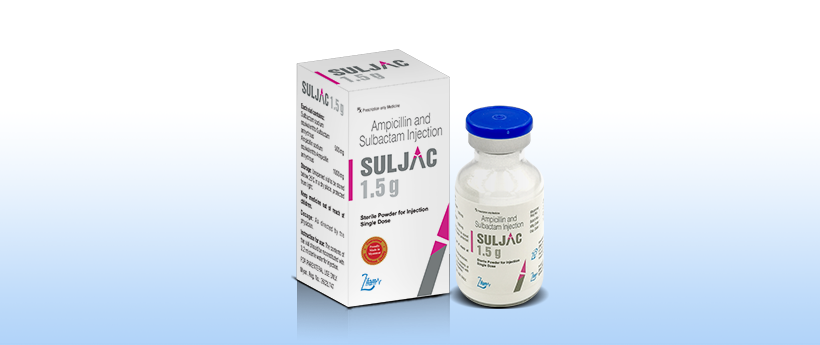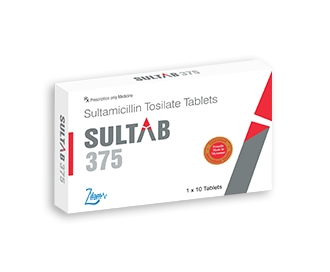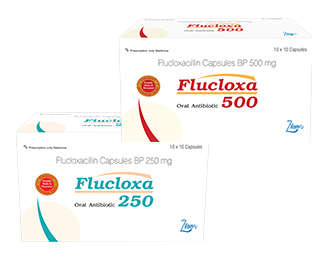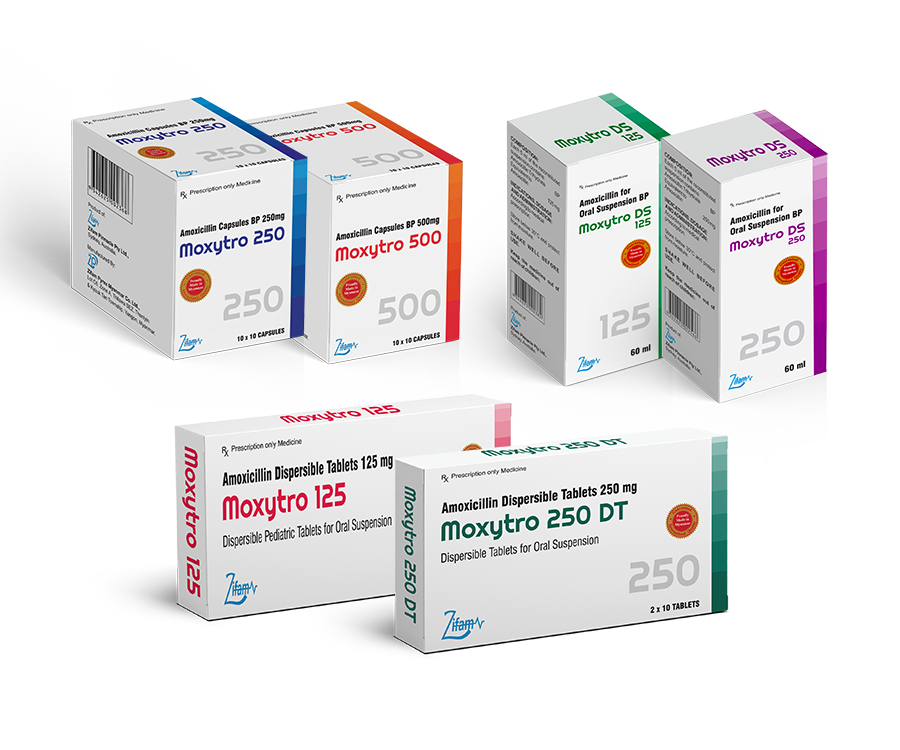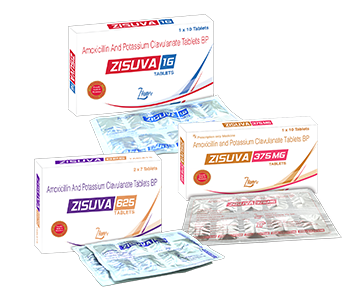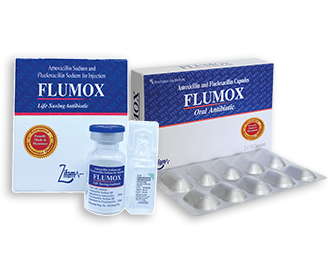SULJAC 1.5 g
- ENG
- မြန်မာ
Composition
Each vial contains:
Sulbactam sodium
Equivalent to Sulbactam anhydrous …….. 500 mg
Ampicillin sodium
Equivalent to Ampicillin anhydrous……….. 1000 mg
Description
Sulbactam sodium is a derivative of the basic penicillin nucleus. Chemically it is sodium penicillanate sulfone and is an off-white crystalline powder highly soluble in water. The molecular weight is 255.22. Ampicillin sodium is derived from the penicillin nucleus, 6-aminopenicillanic acid. Chemically, it is D (-)-aminobenzyl penicillin sodium salt and has a molecular weight of 371.39.
Sulbactam sodium/ampicillin sodium IM/IV contains sulbactam sodium and ampicillin sodium in a 1:2 ratio.
PHARMACEUTICAL FORM
Sulbactam sodium/ ampicillin sodium IM/IV combination is available as a dry powder for reconstitution in vials containing the equivalent of 500 mg + 1000 mg of sulbactam and ampicillin, respectively.
CLINICAL PARTICULARS
Therapeutic Indications
Sulbactam sodium/ampicillin sodium IM/IV is indicated for infections caused by susceptible microorganisms. Typical indications are upper and lower respiratory tract infections including sinusitis, otitis media and epiglottitis; bacterial pneumonias; urinary tract infections and pyelonephritis; intra-abdominal infections including peritonitis, cholecystitis, endometritis and pelvic cellulitis; bacterial septicemia; skin, soft tissue, bone and joint infections and gonococcal infections.
Sulbactam sodium/ampicillin sodium IM/IV may also be administered peri-operatively to reduce the incidence of post-operative wound infections in patients undergoing abdominal or pelvic surgery, in which peritoneal contamination may be present. In termination of pregnancy or cesarean section, sulbactam sodium/ampicillin sodium IM/IV may be used prophylactically lo reduce post-operative sepsis.
Posology and Method of Administration
Sulbactam sodium/ampicillin sodium IM/IV can be administered by either intravenous or intramuscular routes.
For intravenous administration, sulbactam sodium/ampicillin sodium IM/IV should be reconstituted with sterile waler for injection or any compatible solution (see section 6.6 – Special Precautions for Disposal and Other Handling). To ensure complete dissolution, allow foaming to dissipate in order to visually inspect. The dose can be given by bolus injection over a minimum of 3 minutes or can be used in greater dilutions as an intravenous infusion over 15-30 minutes.
Sulbactam sodium/ampicillin sodium parenteral may also be administered by deep intramuscular injection; if pain is experienced, 0.5% sterile solution for injection of lignocaine hydrochloride anhydrous may be used for reconstitution of the powder.
Use in Adults
The usual dosage range of sulbactam sodium / ampicillin sodium IM/M is 1.5 g to 12 g per day in divided doses every & or 8 hours up to a maximum daily dosage of sulbactam of 4 g. Less severe infections may be treated on an every-12-hours schedule.
| SEVERITY OF INFECTION | DAILY DOSE OF sulbactam sodium/ ampicillin sodium IM/IV (g) |
| Mild | 1,5 to 3 (0,5 + 1 to 1 + 2) |
| Moderate | up to 6 [2 + 4) |
| Severe | up to 12 (4 + 8) |
More or less frequent dosing may be indicated depending on the severity of the illness and the renal function of the patient. Treatment is usually continued until 48 hours after pyrexia and other abnormal signs have resolved. Treatment is normally given for 5 to 14 days, but the treatment period may be extended or additional ampicillin may be administered in severely ill cases.
In treating patients on restricted sodium intake, 11 should be noted that 1,500 mg of sulbactam sodium/ampicillin sodium IM/IV contains approximately 115 mg (5 mmol) of sodium. For the prophylaxis of surgical infections, 1.5-3 g of sulbactam sodium / ampicillin sodium IM/IV should be given at induction of anesthesia, which allows sufficient lime to achieve. effective serum and tissue concentrations during the procedure. The dose may be repasted even 6-8 hours: administration is usually stopped 24 hours after the majority of surgical procedures, unless a therapeutic course of sulbactam sodium/ampicillin sodium IM/IV is indicated.
In the treatment of uncomplicated gonorrhea sulbactam sodium/ampicillin sodium IM/IM can be given as a single dose of 1,5 g. Concomitant probenecid 1,0 g orally should be administered in order to prolong plasma concentrations of sulbactam and ampicillin.
Use in Children, Infants and Neonates
The dosage of sulbactam sodium/ampicillin sodium IM/IV for most infections in children, infants and neonates is 150 mg/kg/day (corresponding lo sulbactam 50 mg/kg/day and ampicillin 100 mg/kg/day) In children, infants and neonates, dosing is usually every 6 or 8 hours in accordance with the usual practice for ampicillin. In neonates during the first week of life (especially preterms), the recommended dose is 75 mg/kg/day (corresponding to 25 mg/kg/day sulbactam and 50 mg/kg/day ampicillin| in divided doses every 12 hours.
Use in Patients with Renal Impairment
In patients with severe impairment of renal function (creatinine clearance 330 ml/min), the elimination kinetics of sulbactam and ampicillin are similarly affected and hence the plasma ratio of one to the other will remain constant. The dose of sulbactam sodium/ampicillin sodium IM/IV in such patients should be administered less frequently in accordance with the usual practice for ampicillin.
Contraindications
The use of this combination is contraindicated in individuals with a history of an allergic reaction to any of the penicillins.
Special Warnings and Special Precautions for Use
Serious and occasionally fatal hypersensitivity (anaphylactic] reactions have been reported in patients on penicillin therapy including sulbactam sodium/ampicillin sodium IM/IV. These reactions are more opt to occur in individuals with a history of penicillin hypersensitivity and/or hypersensitivity reactions to multiple allergens. There have been reports of individuals with a history of penicillin hypersensitivity who have experienced severe reactions when treated with cephalosporins. Before therapy with a penicillin, careful inquiry should be made concerning previous hypersensitivity reactions to penicillins, cephalosporins and other allergens. li on allergic reaction occurs, the drug should be discontinued and the appropriate therapy instituted.
Serious anaphylactic reactions require immediate emergency treatment with epinephrine.
Oxygen, intravenous steroids and airway management, including intubation, should be administered as indicated.
Severe skin reactions, such as toxic epidermal necrolysis (TEN). Stevens-Johnson syndrome (SJS), dermatitis exfoliative, erythema multiforme, and acute generalized exanthematous pustulosis (AGEP) have been reported in patients on ampicillin/ sulbactam therapy If o severe skin reaction occurs, ampicillin/ sulbactam should be discontinued and appropriate therapy should be initiated (see section 4.8-Undesirable Effects)
As with any antibiotic preparation, constant observation for signs of overgrowth of non-susceptible organisms, including fungi, is essential.
Should superinfection occur, the drug should be discontinued and/or appropriate therapy instituted
Clostridium difficile associated diarrhea (CDAD) has been reported with use of nearly all antibacterial agents, including sulbactam sodium/ampicillin sodium, and may range in severity from mild diarrhea to fatal colitis. Treatment with antibacterial agents alters the normal flora of the colon leading to overgrowth of C difficile. 1-14
- difficile produces toxins A and B which contribute to the development of CDAD. Hypertoxin producing strains of C. difficile cause increased morbidity and mortality, as these infections can be refractory to antimicrobial therapy and may require colectomy. CDAD must be considered in all patients who present with diarrhea following antibiotic use. Careful medical history is necessary since CDAD has been reported to occur over two months after the administration of antibacterial agents.
Drug induced liver injury such as cholestatic hepatitis and jaundice have been associated with the use of ampicillin/ sulbactam. Patients should be advised to contact their doctor it signs and symptoms of hepatic disease develop. (see Section 4.8- Undesirable Effects).
As with any potent systemic agent. it is advisable to check periodically for organ system dysfunction during extended therapy; this includes renal, hepatic and hematopoietic systems. This is particularly important in neonates, especially when premature, and other infants.
Since infectious mononucleosis is viral in origin. sulbactam sodium/ampicillin sodium IWIV should not be used in its treatment. A high percentage of patients with mononucleosis who received ampicillin have developed a skin rash.
Interaction with Other Medicinal Products and Other Forms of Interaction
Allopurinol: The concurrent administration of allopurinol and ampicillin substantially increases the incidence of rashes in patients receiving both drugs as compared with patients receiving ampicillin alone.
Aminoglycosides: Mixing ampicillin with aminoglycosides in vitro has resulted in substantial mutual inactivation; it these groups of antibacterials are to be administered concurrently, they should be administered at separate sites at least 1 hour apart (see section 6.2 – Incompatibilities).
Anticoagulants: Parenteral penicillins can produce alterations in platelet aggregation and coagulation tests. These effects may be additive with anticoagulants.
Bacteriostatic drugs (chloramphenicol, erythromycin, sulfonamides and tetracyclines): Bacteriostatic drugs may interfere with the bactericidal effect of penicillins; il is best to avoid concurrent therapy.
Estrogen containing oral contraceptives; There have been case reports of reduced oral contraceptive effectiveness in women taking ampicillin, resulting in unplanned pregnancy. Although the association is weak, patients should be given the option to use an alternate or additional method of contraception while taking ampicillin.
Methotrexate: Concurrent use with penicillins has resulted in decreased clearance of methotrexate and in methotrexate toxicity. Patients should be closely monitored. Leucovorin dosages may need to be increased and administered for longer periods of time.
Probenecid: Probenecid decreases renal tubular secretion of ampicillin and sulbactam when used concurrently; this effect resulted in increased and prolonged serum concentrations, prolonged elimination halt-lite, and increased risk of toxicity
Laboratory test interactions: False-positive glycosuria may be observed in urinalysis using Benedict reagent, Fehling reagent, and Clinitest. Following administration of ampicillin to pregnant women, a transient decrease in plasma concentration of total conjugated estriol, estriol-glucuronide, conjugated estrone and estrial has been noted, This effect may also occur with sulbactam sodium/ampicillin sodium IM/ IM.
Fertility, Pregnancy and Lactation
Animal reproduction studies have revealed no evidence
of impaired fertility or harm to the fetus due to sulbactam and ampicillin. Sulbactam crosses the placental barrier. Safety for use in pregnancy and lactation has not been established
Effects on Ability to Drive and Use Machines
None known
Undesirable Effects
Adverse reactions associated with the use of ampicillin alone may be observed with sulbactam sodium / ampicillin sodium IM/IV.
All ADRs listed in the CDS one presented by MedDRA
SOC. Within each frequency category. the ADRs are presented in the order of seriousness. Seriousness of the ADRs was determined by clinical importance.
Overdose
Limited information is available on the acute toxicity of ampicillin sodium and sulbactam sodium in humans. Overdosage of the drug would be expected to produce manifestations that are principally extensions of the adverse reactions reported with the drug. The fact that high CSF concentrations of B-lactam antibiotics may cause neurologic effects, including seizures, should be considered. Because ampicillin and sulbactam are both removed from the circulation by hemodialysis, these procedures may enhance elimination of the drug from the body if overdosage occurs in patients with impaired renal function.
PHARMACOLOGICAL PROPERTIES
Pharmacodynamic Properties
Biochemical studies with cell free bacterial systems have shown sulbactam to be an irreversible inhibitor of most important beta-lactamases that occur in penicillin-resistant organisms. While sulbactam’s antibacterial activity is mainly limited to Neisseriaceae, the potential for sulbactam sodium in preventing the destruction of penicillins and cephalosporins by resistant organisms was confirmed in whole organism studies using resistant strains, in which sulbactam sodium exhibited marked synergistic effects with penicillins and cephalosporins. Since sulbactam also binds to some penicillin-binding proteins, some sensitive strains are rendered more susceptible to the combination than to the beta-lactam antibiotic alone.
The bactericidal component of the combination is ampicillin which, like benzyl penicillin, acts against sensitive organisms during the stage of active multiplication by the inhibition of biosynthesis of cell-wall mucopeptide. Sulbactam sodium/ampicillin sodium IM/IV is effective against a wide range of Gram positive and Grom-negative bacteria including: Staphylococcus aureus and epidermidis including penicillin-resistant and some methicillin-resistant strains): Streptococcus pneumoniae, Streptococcus fecalis and other Streptococcus species: Haemophilus influenzae and parainfluenzae (both beta-lactamase positive and negative strains): Branhamello catarrhalis; anaerobes, including Bacteroides fragilis and related species; Escherichia coli, Klebsiella species, Proteus species (both indole-positive and indole-negative), Morganelli morganii, Citrobacter species, Enterobacter species Neisseria meningitidis and Neisseria gonorrhoeae.
5.2 Pharmacokinetic Properties
Sulbactam sodium/ampicillin sodium IM/IV diffuses readily into most body tissues and fluids in the human.
Penetration into brain and spinal fluids low except when meninges are inflamed. High concentrations of sulbactam and ampicillin are achieved in the blood following intravenous or intramuscular administration and both components have a half-life of approximately 1 hour. Most of the sulbactam sodium/ampicillin sodium IM/IV is excreted unchanged in the urine.
PHARMACEUTICAL PARTICULARS
List of Excipients
None
Incompatibilities
Sulbactam sodium/ampicillin sodium IM/IM and aminoglycosides should be reconstituted and administered separately, due to the in vitro inactivation of aminoglycosides by any of the aminopenicillins.
Shelf-life
24 months
Storage Condition
Unopened vial to be stored below 25’C in a dry place protected from light.
Keep out of reach of children.
Special Precautions for Disposal and Other Handling
Sulbactam sodium is compatible with most intravenous solutions, but ampicillin sodium and hence sulbactam sodium/ampicillin sodium IM/IV is less stable in solutions containing dextrose or other carbohydrates, and should not be mixed with blood products or protein hydrolysates.
Ampicillin and hence sulbactam sodium / ampicillin sodium IM/IV is incompatible with aminoglycosides and should not be physically mixed in the same container (see section 4,2 – Posology and Method of Administration), The concentrated solution for intramuscular administration should be used within 1 hour of reconstitution. Time periods for use with different diluents for intravenous infusion are as follows:
| Diluent | Concentration Sulbactam + Ampicillin | Used Periods
(in hours) |
|
| 25 ֯C | 4 ֯C | ||
| Sterile Water for Injection | Up to 45 mg / ml
45 mg / ml Up to 30 mg / ml |
8 | 48
72 |
| Isotonic Sodium Chloride | Up to 45 mg / ml
45 mg / ml Up to 30 mg / ml |
8 | 48
72 |
| M/6 Sodium Lactate Solution | Up to 45 mg / ml
Up to 45 mg / ml |
8 | 8 |
| 5% Dextrose in Water | 15 to 30 mg / ml
Up to 3 mg / ml Up to 30 mg / ml |
2
4 |
4 |
| 10% Invert Sugar in Water | Up to 3 mg / ml
Up to 30 mg / ml |
4 | 3 |
| Lactated Ringer’s Solution | Up to 45 mg / ml
Up to 45 mg / ml |
8 | 24 |
Packing
Each vial of 1.5 g packed in a carton along with pock insert.






